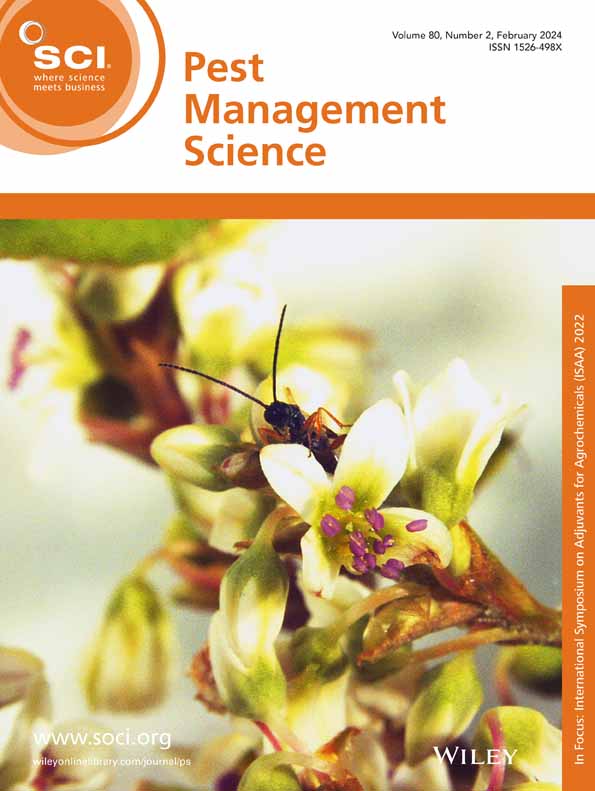基于纳米颗粒的融合dsRNA递送系统对抗害虫杀虫剂抗性的新策略
IF 3.8
1区 农林科学
Q1 AGRONOMY
引用次数: 0
摘要
背景杀虫剂抗药性导致的害虫防治效果下降仍然是对全球粮食安全的重大威胁。虽然RNA干扰(RNAi)介导的关键抗性基因沉默为缓解这一挑战提供了一种有希望的策略,但现场适用的靶向杀虫剂抗性仍然有限。本研究旨在开发一个基于RNAi的喷雾平台,利用融合dsRNA来恢复杀虫剂的功效。结果本研究采用基因靶向策略,通过胺化介孔有机二氧化硅纳米粒子(MON - NH2)与融合双链RNA (dsRNA)的自组装,开发了一种可喷雾的耐药克服系统MON - NH2/dsNlCYP6ER1 - CarE1。MON‐NH2有效地保护了dsRNA的降解,增强了RNAi的持久性。该系统通过抑制耐药相关基因nlyp6er1和NlCarE1的表达,在实验室条件下显著提高了耐药褐褐Nilaparvata lugens群体对多种杀虫剂的敏感性。田间试验进一步表明,MON‐NH2/dsNlCYP6ER1‐CarE1与杀虫剂联合施用可显著提高对褐飞虱的防治效果。结论本研究引入了一种利用融合dsRNA破坏代谢抗性途径的基因靶向杀虫剂抗性管理策略。它的田间效果强调了RNAi在恢复杀虫剂有效性方面的潜力,并代表了向机制驱动的害虫控制的范式转变。©2025化学工业协会。本文章由计算机程序翻译,如有差异,请以英文原文为准。
A novel strategy to combat insecticide resistance in insect pest with a nanoparticle‐based fusion dsRNA delivery system
BACKGROUNDThe decline in pest control efficacy due to insecticide resistance remains a significant threat to global food security. While RNA interference (RNAi)‐mediated silencing of key resistance genes offers a promising strategy to mitigate this challenge, and field‐applicable targeting insecticide resistance remains limited. This study aimed to develop an RNAi‐based spray platform utilizing fusion dsRNA to restore the efficacy of insecticides.RESULTSIn this study, a gene‐targeting strategy was employed to develop a sprayable resistance‐overcoming system, MON‐NH2 /dsNlCYP6ER1‐CarE1 , through the self‐assembly of aminated mesoporous organosilica nanoparticles (MON‐NH2 ) with fusion double‐stranded RNA (dsRNA). The MON‐NH2 effectively protects dsRNA from degradation and enhances RNAi persistence. By suppressing the expression of resistance‐associated genes, NlCYP6ER1 and NlCarE1 , the system significantly increased the susceptibility of resistant Nilaparvata lugens populations to multiple insecticides under laboratory conditions. Field trials further demonstrated that the combined application of MON‐NH2 /dsNlCYP6ER1‐CarE1 with insecticides significantly improved control efficacy against N. lugens .CONCLUSIONThis study introduces a gene‐targeted insecticide resistance management strategy utilizing fusion dsRNA to disrupt metabolic resistance pathways. Its field efficacy underscores the potential of RNAi to restore insecticide effectiveness and represents a paradigm shift toward mechanism‐driven pest control. © 2025 Society of Chemical Industry.
求助全文
通过发布文献求助,成功后即可免费获取论文全文。
去求助
来源期刊

Pest Management Science
农林科学-昆虫学
CiteScore
7.90
自引率
9.80%
发文量
553
审稿时长
4.8 months
期刊介绍:
Pest Management Science is the international journal of research and development in crop protection and pest control. Since its launch in 1970, the journal has become the premier forum for papers on the discovery, application, and impact on the environment of products and strategies designed for pest management.
Published for SCI by John Wiley & Sons Ltd.
 求助内容:
求助内容: 应助结果提醒方式:
应助结果提醒方式:


